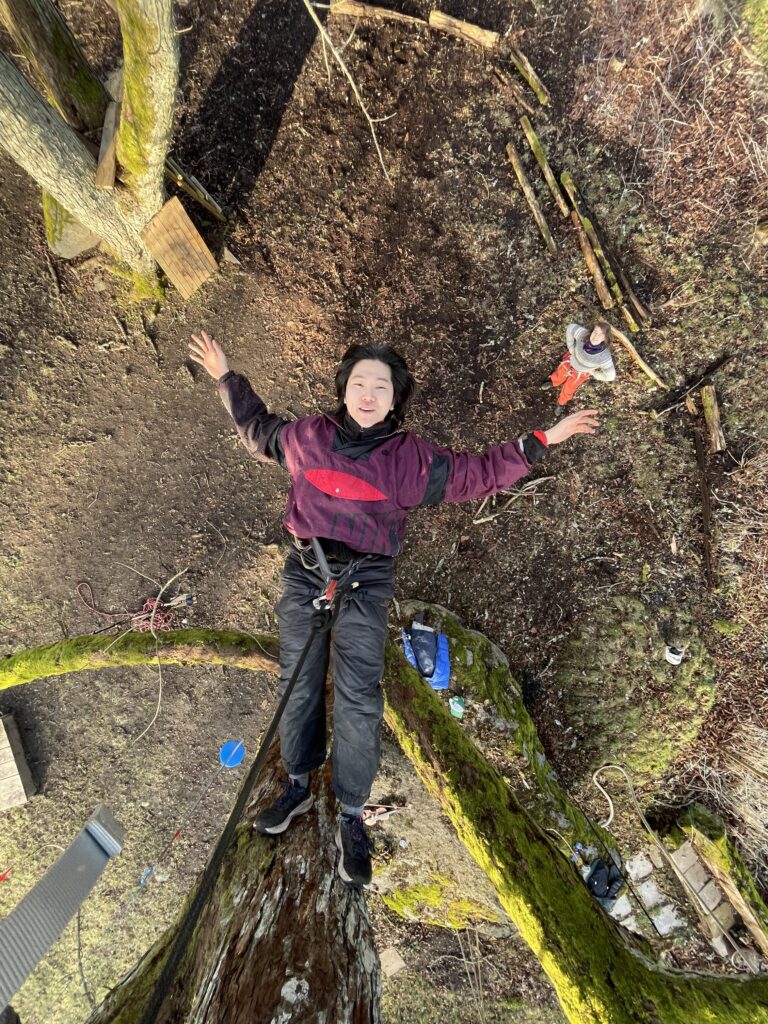”Her name was Grønnmose. A beautiful huge birch just at the entrance of the forest. I guess we named her after the green layer of moss which was covering her skin. She was our secret, our own tree-friend. She had large branches growing from her trunk. They reached for the sky so she was almost a collection of several trees in one tree. Creating a platform, not too easy, but still managable to climb up to. We would talk to her, telling her secrets we wouldnt tell grown-ups and we were sure she was listening. We had this special ritual we used to greet her. First we would struggle quite a lot to get up to her first branches. I remember crawling diagonally up on this long, slim, rotten stick to reach up. There she had a small round naked spot with no bark on. We would spit in our hands and rubb it on this spot. We were sure that there was living whole societies of elves inside of her, which our human-eyes could not see. We were never afraid of falling down while climbing her, because we were sure she would reach out and catch us with her long branches if we fell.
My mother also played in this tree when she was a child, and I wonder how many has a relation to the same tree, or have another tree-friend somewhere else in the world”
Tree
To work outdoors in a tree, with the landscape as a stage room. Can trees connect human beings across generations, ages and cultures? The tree has stood there before we arrived, before we were born, it will probably stand there when we have vanished as well. The stage room will still be there after we have left it, so that the audience can go back to it and remember the performance.
We as artists have a responsibility. A stage room has been built up and down and we own it in a way. A tree is a stage room where we are guests. It is a living organism that is ”owned” by the local community and may have symbolic value for some that we do not know about. This requires that what we do is done carefully and with respect.
Site-sensitive
By site-sensitive we mean that the performance is made, but with the opening to be sensitive and adjustable to each new tree we come to. The height affects the rigging, the ground affects the dance, the surroundings affect the acoustics and the framing. The audience’s cultural connection affects how everything is perceived.
For us, it is interesting to have a touring concept as we see it as a way to connect people across cultures and geography around our relationships to trees.
Placement of the audience
We will place the audience around the trunk of the tree. Perhaps the innermost circle is lying on a mattress looking up towards the treetops, the middle one sitting on the ground, while the back one is standing. Lying on the ground and looking up at the treetops evokes other associations than standing a little further away and seeing the whole tree. The experience is unique for each audience member based on where they are located and what perspective they get. We want the audience to be passive. They should be at peace to sit and absorb the impressions and let the mind wander. Even if we do not ask them to do something, they will still be part of the whole, equal as the performers and the tree. Sitting with your body close together in the field under a tree, the feeling of the grass, the smells, the wind, and the memories makes the audience participate with their whole body.

Aerial acrobatics
As a stage room, a tree is interesting for aerial acrobats as it is circular and three-dimensional. Circus, the genre where aerial acrobatics originates, traditionally has a circular stage where the performers use the stage room in three dimensions.
To be able to move in all dimensions of the tree also out on the branches, requires physical and technical knowledge, both to be safe and with a certain aesthetic quality. The actual design of the tree provides opportunities and challenges for aerial acrobats. Normally, aerial acrobats move in disciplines that have a set shape, a rope or a trapez. In the tree, the aerial acrobats get to examine and transform their skills into new forms.
We will examine movements and qualities that evoke memories of childlike freedom, the ancient old slow tree, as well as movements that are more inspired animalistic. We want to create images that give associations to our own experiences or dreams of climbing trees.
Traditional music
Like the tree that has lived and grown through generations, traditional music has too, and belongs to the tree in a strange way, with roots from a bygone era. The musicians relate in a playful manner to the tradition and are innovative in their compositions and performance. A fiddle is created from wood, and in many ways it is the sound of a tree we hear when the bow slides over the fiddle strings and the vibrations expand into the landscape.
The songs contain some text, although text and words are not central to the transmission of the foresight. The voice is an instrument and the word can be a rhythmization in the context for those who do not understand the language.
Composing music to and about three, have been done throughout all times. We explore and are inspired by this cultural heritage.
The music is a composed whole that combines associations, traditions and imitations of the sounds that come from a tree.
In order to capture minimalist sounds outdoors, we use some microphones and speakers, so the sound can carry forward.
We experiment with going in and out of amplified sound, something that can expand the stage space as one can experience the sound as near or far away. We also see potential in how the wood-like and organic sound can meet the electronic through the use of, for example, effect pedals.
We treat the tree as an instrument by exploring it percussively and hanging up various sound instruments in the branches. The performance will have an interdisciplinary method and all participants will be active in the musical performance.
Contemporary dance
We explore the idea of the body as a storage space that can be empty, full, light, heavy, intricate, simple, complex and more. We want to embody from thought or concept as an initiative, rely on physical memory and knowledge from other physical experiences.
We want to embody the confusion of memories associations and depths that a tree carries with it. Through the dance, we explore a physical method that can be applied both on the ground, in the tree and in the air between them.
Languageless language
Not using words can make room for the audience’s own thoughts and memories. Music and movement can communicate directly on an emotional level and give space to the audience’s own thoughts and memories.

